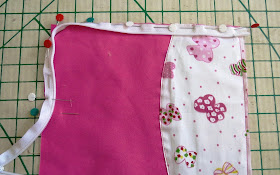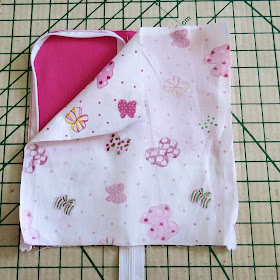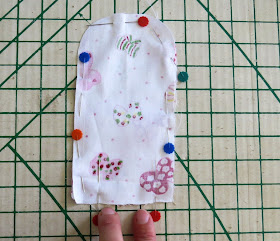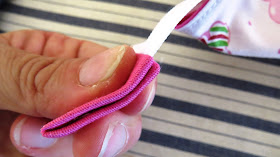A few days ago, I had an email from a reader of my blog asking if I would mind if my patterns and tutorials were used to make things to sell on Etsy or in other market places. My reply was that I don't mind at all.
I don't claim that any of my tutorials are original ideas or exclusive in any way.
There are hundreds and thousands of sewing tutorials available all over the place - for many of the same things. I've simply written tutorials for things I've wanted to make - in my own style. I am a teacher and I love teaching - writing and sharing sewing tutorials is just that - a form of teaching.
To know I've helped people understand how to make something and encourage and enable others to make things too is something I find very rewarding.
There are hundreds and thousands of sewing tutorials available all over the place - for many of the same things. I've simply written tutorials for things I've wanted to make - in my own style. I am a teacher and I love teaching - writing and sharing sewing tutorials is just that - a form of teaching.
To know I've helped people understand how to make something and encourage and enable others to make things too is something I find very rewarding.
I love when I get emails and messages from people who have used my tutorials to make things and proudly show me pictures of the resulting finished item.
Selling Hand Made
As far as making things to sell goes, I give kudos to anyone who can manage to create and hand make things and sell them. I have tried - not very successfully to make and sell my own hand made items.
I started out with a market stall trying to sell 'Bubba Rugs' which I'd made. These rugs were baby rugs with pictures and designs on them made with lots of different textured fabrics.
Admittedly I only did one market stall with these and only sold two rugs - they were to two ladies who thought their dogs might like them!
Admittedly I only did one market stall with these and only sold two rugs - they were to two ladies who thought their dogs might like them!
I did sell some more of these rugs through word of mouth, but mostly I gave them as gifts to friends.
A few years later I tried again, with a market stall selling things I'd handmade with a friend . Our stall was called Jembellish (this is where my blog name came from!). I really enjoyed our monthly market stalls as we always had a lovely day chatting and catching up together. We only ever really sold enough to cover our costs and after a couple of years stopped our stall.
I had an online Madeit store for a while and sold a few items from it.
But 'selling' and promoting things for sale isn't something I enjoy or am good at. I find pricing my items difficult. Since I upcycle and largely 'use what I've got' in terms of supplies, my materials cost next to nothing and so it is just my designs and my time I'm charging for. How do I put a price on that?
But 'selling' and promoting things for sale isn't something I enjoy or am good at. I find pricing my items difficult. Since I upcycle and largely 'use what I've got' in terms of supplies, my materials cost next to nothing and so it is just my designs and my time I'm charging for. How do I put a price on that?
The things I had for sale in my Madeit shop were priced inclusive of postage. Postage in Australia is very expensive, and I didn't want people to purchase something from my shop only to find that it costs more to post the item to them than the item itself cost. This again reduced the profit for me significantly.
In short - I don't feel it's worthwhile me making things to sell as I don't believe people will pay a high enough price to make it profitable.
Anything that I make, you can probably buy a cheaper version of the same thing in the shops for just a few dollars. Made overseas from cheap plastic, bright and colourful and does the job.
How do you persuade people to pay significantly more for a handmade version? Those who hand-make things themselves understand the time and effort involved and so the value of the finished product - but then those people are also the ones who can make things for themselves rather than buy them!
There are people who successfully hand make things and sell them for a decent profit and make a living. Hats off to them. I truly admire these people but that is not the direction I have gone in, nor want to go in.
I'm much happier trying to inspire and encourage people to make things for themselves or use things they already have instead of continuing to buy cheap manufactured things from abroad and perpetuate these industries.
It's not about the money
I don't want to be always looking for the cheapest version of things, the cheapest way to do things, or what will make me the most money. I don't want my focus to be on money, and it isn't.
I've recently made a few teddy bears from old school and sports uniforms. I made one as a school trophy and another as a sporting team mascot.
The others I made for my daughters and a friend as a gift.
The teddy bears were so well received and appreciated and I have had requests for more to be made - and people telling me I should make them to sell. However, when I point out the hours it takes for me to make each bear, and if I even just made minimum wage for my time and nothing else to cover materials, the cost of the bear would be more than people would be willing to pay.
The others I made for my daughters and a friend as a gift.
The teddy bears were so well received and appreciated and I have had requests for more to be made - and people telling me I should make them to sell. However, when I point out the hours it takes for me to make each bear, and if I even just made minimum wage for my time and nothing else to cover materials, the cost of the bear would be more than people would be willing to pay.
I'm happy to make things for people as gifts, or to help out, but making things to sell isn't what I want to do or feel comfortable doing.
So what does that say about me when I'll happily sit for a few hours and make a teddy bear to give to someone at no cost to them, but I won't spend that same time making a teddy bear to sell? I like that people appreciate the things that I make - and money doesn't come into it as a factor. There's no need to listen to anyone saying things are overpriced. I'm sure they would for a $100+ teddy bear that's made out of an old uniform!
So what does that say about me when I'll happily sit for a few hours and make a teddy bear to give to someone at no cost to them, but I won't spend that same time making a teddy bear to sell? I like that people appreciate the things that I make - and money doesn't come into it as a factor. There's no need to listen to anyone saying things are overpriced. I'm sure they would for a $100+ teddy bear that's made out of an old uniform!
I like that the things I make have a value that isn't counted in money.
But I do need money
Although I don't sew and blog for the financial reward - the fact does remain that I do need to make money. We need to pay the bills, buy food, support our kids and be able to afford to do the things we want to do in life. I would dearly love to be able to do this by means of my blog and doing what I love doing and feel passionate about. I feel like I'm achieving something worthwhile with this blog. I'm teaching people to sew and create, inspiring others to upcycle and 'use what you've got' - saving money and the environment in doing so.
By doing what I do personally I know I'm making a small difference in the world and by sharing and spreading the word via my blog, hopefully that small difference will be magnified and spread further and wider in turn making a bigger and bigger difference.
I have spent a few years now, building up my blog, the free sewing tutorials and upcycling inspiration. I've put countless hours into this with no real (as yet) financial reward. I know I can't put this much time and effort into my blog indefinitely without making some money. But I don't want to make money from sponsored posts - selling things for big companies and promoting products, when my whole ethos is to 'use what you've got' rather than just buying things!
I shall have to rely on other means to make money.
I have spent a few years now, building up my blog, the free sewing tutorials and upcycling inspiration. I've put countless hours into this with no real (as yet) financial reward. I know I can't put this much time and effort into my blog indefinitely without making some money. But I don't want to make money from sponsored posts - selling things for big companies and promoting products, when my whole ethos is to 'use what you've got' rather than just buying things!
I shall have to rely on other means to make money.
What I am selling
Although I am not focusing on selling my physical creations, I have created two e-books which I hope will inspire people and create change in the world. Although all my sewing tutorials here on my blog are available for free, I have put a small price on my e-books to try and cover the costs of running my blog and to see if it is possible for me to sell a concept and idea rather than just 'things'.
My first e-book is a complete set of sewing tutorials for making a set of Eco-Friendly shopping bags, that all fit inside a stylish, upcycled handbag, so that you will never forget your reusable shopping bags again, and never need to use a plastic bag again.
My first e-book is a complete set of sewing tutorials for making a set of Eco-Friendly shopping bags, that all fit inside a stylish, upcycled handbag, so that you will never forget your reusable shopping bags again, and never need to use a plastic bag again.
The cost of this e-book is just the cost of a cup of coffee
AU$5. I priced this book low and affordable in the hope that lots of people will buy it and make the bags - again helping to make a bigger difference in the world!
I have been asked if I would make a set of these bags for someone and they would pay me for it. However, when I pointed out the time it would take me to make the set and the cost of my time - even at just minimum wage levels - people aren't willing to buy at that price. Which is why I encourage people to make things for themselves - at a cost of nothing other than their time.
The tutorials I make are as detailed, clear and simple as I can possibly make them, and I truly believe that anyone with basic sewing skills, a machine and a little patience can make these bags themselves.
To read more about this e-book, and 'share a cup of coffee with me" go here!
To read more about this e-book, and 'share a cup of coffee with me" go here!
My second e-book is one I have been requested several times over the years to create, and finally did. It's a book to teach your kids to sew.
But I wanted it to be different and to teach and encourage more than just the 'sewing' itself, so this e-book shows how to
But I wanted it to be different and to teach and encourage more than just the 'sewing' itself, so this e-book shows how to
"Teach your kids to sew with a pair of jeans". It details how to upcycle jeans, use the fabric and various 'parts' of the jeans to sew and create. Teaching the value of 'using what you've got' and that you can create things you need and want from the resources we have available on hand. The answer is not always to just spend money and buy things.
This book is priced a little higher than the first at AU$10, but I still believe it provides great value for money and is more than just a collection of sewing tutorials.
To learn more about this book or even purchase a copy - go here!
To learn more about this book or even purchase a copy - go here!
Making millions?
Nope - not yet anyway! I sell a couple of books a month, and I have Google ads on my blog. Some months I do better than others, but mostly I do little more than cover costs. I've chosen to stick with a Blogger blog which is free.
I do have a dream that one day, I'll find that one post - or the right person will stumble across my blog and send it viral, causing a clicking frenzy on my e-books for sale, and the small amount of advertising I do have on my blog.
I firmly believe it is possible for me to make a living from my blog, which encourages people to 'do things themselves' and 'not spend money'!
I have put hours of my time and effort into building this blog - creating content, and trying to inspire, encourage and motivate. But I know I'm really trying to 'Create my way to Success' in an unconventional way.
I will get there one day, somehow!
This is me!
So returning to the original question that sparked my musings about what I do - YES, please do use my tutorials and patterns to make things to sell. And if you manage to do this and make a living or even a little extra money from it, do let me know and I'll be the first to cheer you on and support you!
Teaching is what I'm trained to do. I teach casually - both English as a foreign language, and now also learn to swim classes.
I find teaching rewarding in the sense that I can help people learn how to do things for themselves and how to continue learning beyond my teaching.
This blog is another use of my teaching skills and I love it.
Hopefully, that magic viral post will happen soon and I can continue to spend my time motivating, inspiring, teaching sewing and the principals of 'use what you've got' !
How about you?
What do you do? and why do you do it? I'd love to hear your stories and thoughts too.











































































































